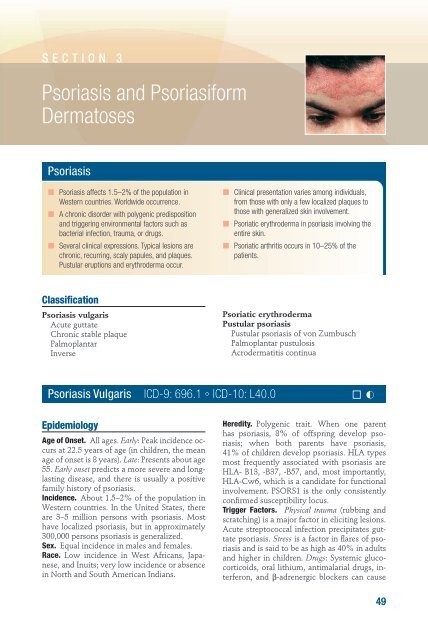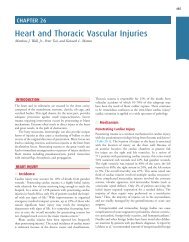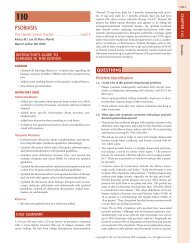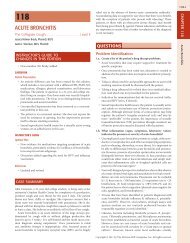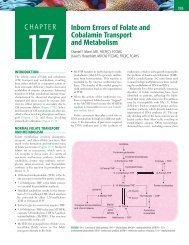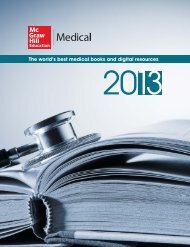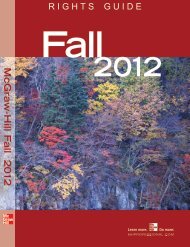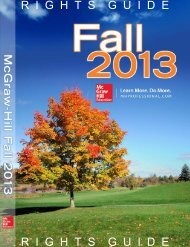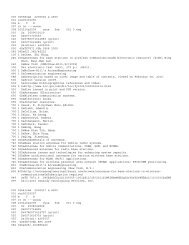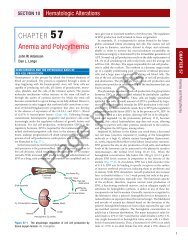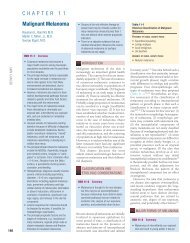TOC and Sample Chapters - McGraw-Hill Professional
TOC and Sample Chapters - McGraw-Hill Professional
TOC and Sample Chapters - McGraw-Hill Professional
You also want an ePaper? Increase the reach of your titles
YUMPU automatically turns print PDFs into web optimized ePapers that Google loves.
S e c t i o n 3<br />
Psoriasis <strong>and</strong> Psoriasiform<br />
Dermatoses<br />
Psoriasis<br />
■ Psoriasis affects 1.5–2% of the population in<br />
Western countries. Worldwide occurrence.<br />
■ A chronic disorder with polygenic predisposition<br />
<strong>and</strong> triggering environmental factors such as<br />
bacterial infection, trauma, or drugs.<br />
■ Several clinical expressions. Typical lesions are<br />
chronic, recurring, scaly papules, <strong>and</strong> plaques.<br />
Pustular eruptions <strong>and</strong> erythroderma occur.<br />
Classification<br />
Psoriasis vulgaris<br />
Acute guttate<br />
Chronic stable plaque<br />
Palmoplantar<br />
Inverse<br />
■ Clinical presentation varies among individuals,<br />
from those with only a few localized plaques to<br />
those with generalized skin involvement.<br />
■ Psoriatic erythroderma in psoriasis involving the<br />
entire skin.<br />
■ Psoriatic arthritis occurs in 10–25% of the<br />
patients.<br />
Psoriatic erythroderma<br />
Pustular psoriasis<br />
Pustular psoriasis of von Zumbusch<br />
Palmoplantar pustulosis<br />
Acrodermatitis continua<br />
Psoriasis Vulgaris ICD-9: 696.1 ° ICD-10: L40.0 ◐<br />
Epidemiology<br />
Age of Onset. All ages. Early: Peak incidence occurs<br />
at 22.5 years of age (in children, the mean<br />
age of onset is 8 years). Late: Presents about age<br />
55. Early onset predicts a more severe <strong>and</strong> longlasting<br />
disease, <strong>and</strong> there is usually a positive<br />
family history of psoriasis.<br />
Incidence. About 1.5–2% of the population in<br />
Western countries. In the United States, there<br />
are 3–5 million persons with psoriasis. Most<br />
have localized psoriasis, but in approximately<br />
300,000 persons psoriasis is generalized.<br />
Sex. Equal incidence in males <strong>and</strong> females.<br />
Race. Low incidence in West Africans, Japanese,<br />
<strong>and</strong> Inuits; very low incidence or absence<br />
in North <strong>and</strong> South American Indians.<br />
Heredity. Polygenic trait. When one parent<br />
has psoriasis, 8% of offspring develop psoriasis;<br />
when both parents have psoriasis,<br />
41% of children develop psoriasis. HLA types<br />
most frequently associated with psoriasis are<br />
HLA- B13, -B37, -B57, <strong>and</strong>, most importantly,<br />
HLA-Cw6, which is a c<strong>and</strong>idate for functional<br />
involvement. PSORS1 is the only consistently<br />
confirmed susceptibility locus.<br />
Trigger Factors. Physical trauma (rubbing <strong>and</strong><br />
scratching) is a major factor in eliciting lesions.<br />
Acute streptococcal infection precipitates guttate<br />
psoriasis. Stress is a factor in flares of psoriasis<br />
<strong>and</strong> is said to be as high as 40% in adults<br />
<strong>and</strong> higher in children. Drugs: Systemic glucocorticoids,<br />
oral lithium, antimalarial drugs, interferon,<br />
<strong>and</strong> β-adrenergic blockers can cause<br />
49


